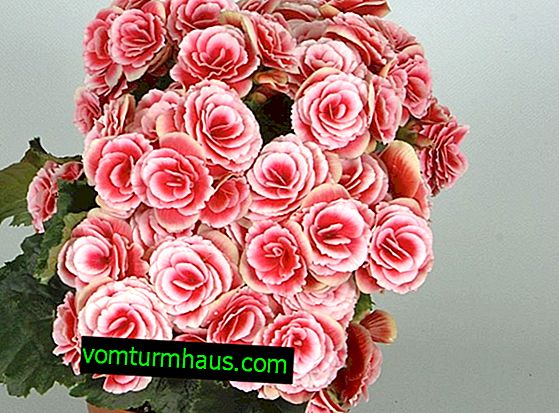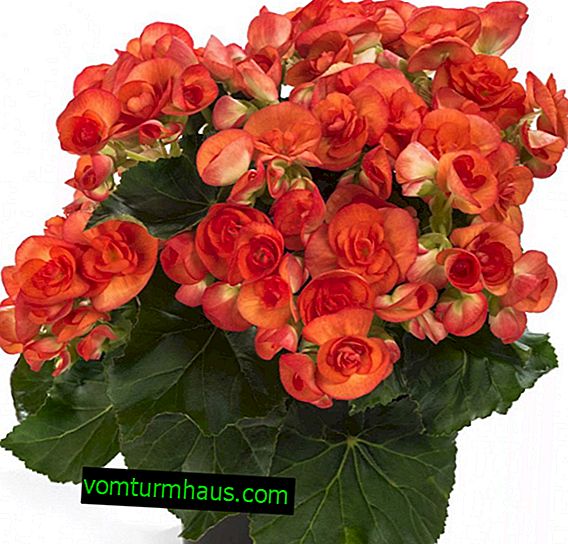How to care for begonia elatior at home
This flower with a magnificent name and with even more magnificent flowering rewards its owners for caring for the long-term riot of colors. The ways of caring for begonia elatior, its cultivation and reproduction at home will be discussed in the article.
Botanical description of the plant
This type of begonia is a perennial shrub that grows to a height of 40 cm. What it represents in the botanical plan can be judged by this table:
| Root system | Compact |
| Stem | Fleshy, erect, thick |
| Leaf shape | Carved oblique |
| Leaf color | Saturated glossy green |
| Flower shape | Large, simple or terry |
| Flower color | White, Red, Yellow, Pink, Coral, Orange |
| Fruit shape | Trihedral box |
| Fruit color | Brown |
| Fruit flavor | - |
This picturesque view was obtained by crossing a tuber and Socotran begonia and is now represented by three groups of plants that differ in stem height, in the form:
- stunted, reaching a maximum of 25 cm;
- medium-sized, growing to 35 cm;
- tall, rising to 45 cm.
Varieties
In addition to this classification, there are several more varieties of begonia elatior, most often cultivated in the home:
- Variety Baladin, which creates, thanks to differently tall peduncles, the appearance of a multi-tiered bouquet, from afar resembling a bouquet of roses, planted in a pot;

- the English variety Borias, characterized by large coral and pink flowers, is even more reminiscent of roses, but blooms longer and more magnificent;

- a native of Southeast Asia - Grace, growing not higher than 35 cm, is covered with a powerful hat of red flowers that bloom repeatedly throughout the year and do not fade for 2-3 months.

When and how to transplant after purchase
Florists do not recommend replanting a flower immediately after purchase. The plant should be allowed to acclimatize for at least a week and a half.
Important! If during the purchase of begonia elatior she is in the flowering stage, then the plant must be transplanted no earlier than when it ends. Since begonias have small roots, a small pot is also suitable for transplanting it after purchase. More important is the composition of the soil, which should be loose, nutritious and have the ability to retain moisture.
The peat, humus and earthen mixture in equal proportions, slightly diluted with river sand and perlite, is best suited for this. Then the young begonia should be transplanted annually, each time increasing the diameter of the new capacity by 5 cm, until the flower reaches 4 years of age, after which the plant is no longer recommended to be disturbed.
Elatior begonia care at home
For any plant, the optimal conditions are those that are most similar to its natural habitat.
Since begonia comes from the tropics, it is preferable to:
- constant heat;
- high enough humidity;
- regular watering;
- fertile soil.














Location
Living in the natural habitat of the tropical jungle, the ancestors of Begonia elatior are used to bright, but at the same time diffused light, which should be provided to the home plant. Therefore, if it stands on a windowsill, where a lot of sunshine falls in the summer, you need to cover the bottom of the window with white paper.
But in cloudy weather and on short daylight days in autumn and winter, this flower, unlike its other relatives, does not require additional lighting. The main thing is that it should not be exposed to cold as well as dry and hot air from central heating, which is no less harmful to it than cold.
Temperature and humidity
The most comfortable temperature for the plant lies within +18 ... + 20 ° С. If it drops below +16 ° C, this is fraught with dropping buds and even plant disease.
Important! It is strongly not recommended to spray water on the leaves and especially the begonia elatior flowers. Nevertheless, this plant does not tolerate dry air, and therefore, in the summer and during the intensive work of central heating, some wide tank with water or at least a damp cloth should be placed near the begonia bush.
Watering
This plant is also very sensitive to watering, which should be carried out only with standing water at room temperature. Cold water is detrimental to begonia roots. It should be watered abundantly, preventing the soil from drying out, however excessive watering with stagnant water in the begonia pan is also harmful.

Top dressing
A flower planted in fertile soil needs additional feeding only during flowering, which, however, is rather long in begonia elatior. Complex mineral fertilizers are best suited for this. However, there is a peculiarity specific to begonia, which consists in rejection by the plant of an excessive salt content in the soil.
Therefore, when making fertilizers in a pot with this flower, one should take their amount, half the recommended amount in the instructions. Begonia should not be fed with organic fertilizers, since an excess of nitrogen compounds adversely affects the appearance of the plant.
Pruning
After the flower petals wither, they should immediately remove the old flower stalks, as well as the withered leaves, for which a sharp knife and wood ash are used, which are trimmed with pruning places.
Did you know? The national emblem of North Korea adorns the flower of this particular wonderful plant.
Breeding
It is not difficult to propagate this plant, because for this there are several ways at once in the form of:
- cuttings;
- division of the mother bush;
- breeding by seed.
Cuttings
The best time for this type of begonia breeding is spring or early summer.
The process proceeds as follows:
- The largest and best looking leaves are selected on the plant.
- Selected leaves are cut with a sharp knife, leaving petioles no shorter than 5 cm on them.
- Then the leaves with petioles are planted in a special soil mixture prepared from 1 peat part and 3 sand parts. During planting, make sure that after it the surface of the sheet does not touch the soil.
- A container with planted leaves is placed in a dark place for 2 months.
- Begonias propagate in the same way by means of cuttings taken from stems. The size of the cuttings in this case should not be less than 7 cm. A necessary condition is to plant them in the soil immediately after cutting.

Seeds
Growing begonia elaitor with seeds is much more difficult. The problem is that this plant, being a hybrid, produces seed material very unstable. The best time for planting seeds occurs in late February or early March.
To do this, you must:
- Mix the seed with sand.
- Prepare a special soil, for which peat and sand parts are mixed with 2 earthen parts.
- Then put the container with soil on a pallet filled with heated water. After the soil is completely moistened and cooled to the optimum temperature, sow the seeds in it in a mixture with sand.
- Sprinkle the sown soil on top with water using a spray gun, and then cover with glass or film and at a temperature of up to +25 ° C and 14-hour illumination to withstand until the first shoots appear, which usually peck after about a month.
- A week after this, the sprouts are planted in cups, and after a couple of months - in constant containers in the form of pots.
Important! If purchased seeds are used for planting, then before use they should be treated with a 1% potassium permanganate solution for at least half an hour.
Division of the mother bush
This operation is carried out in the spring so that when dividing the mother bush all the children are with a kidney and a sprout. The places of cuts must be sprinkled with crushed charcoal, and it is desirable to process the roots with the help of “Kornevin”.
Growing difficulties
If the conditions for the maintenance of begonia elatior, which were discussed earlier, are strictly observed, but at the same time problems arise with the development of the plant, then the culprits are infectious diseases or pests.

This may occur in:
- the appearance of a powdery greenish coating on the leaves caused by gray mold, which is fought with the help of the Benomila fungicide;
- white spots on the leaves, which are the consequences of the activity of powdery mildew, destroyed by fungicides;
- blackened and rotting roots, resulting in black rot, which is also fought using fungicides;
- deformation of the leaves and the appearance of yellow spots on them, which is evidence of a viral attack of the cucumber mosaic, from which there is no salvation except the destruction of the diseased flower, replacing the soil and disinfecting the pot;
- tarnishing of leaves and the appearance of cobwebs on them, resulting in a spider mite, which is destroyed with the help of insecticides such as “Karbofos”, “Thiophos” or “Neoron”;
- the appearance on the leaves of numerous points indicating the presence of aphids, which should also be combated with fungicides or using a weekly infusion of a teaspoon of chopped onions in a liter of water.
Also learn about other varieties of begonia: royal begonia, evergreen begonia, mason begonia, coral begonia, tuber begonia and cleopatra begonia.
Begonia elitor, also called winter begonia, pleases a person with magnificent bloom for most of the year, especially during the period when the flora outside the window looks gray and lifeless. But for this it is necessary to make some efforts, which against the background of magical results do not look excessive.






